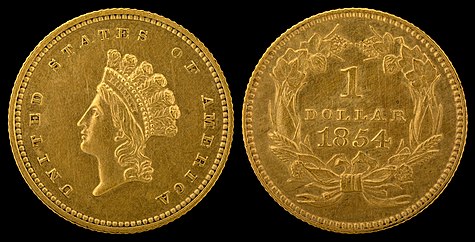Gold dollar
| United States | |
| Value | 1 United States dollar |
|---|---|
| Mass | 1.672 g |
| Diameter | For Type 1, 12.7 mm. For Types 2 and 3, 14.3 mm (For Type 1, .500 inch. For types 2 and 3, .563 in) |
| Edge | Reeded |
| Composition | 90% gold, 10% copper |
| Gold | .04837 troy oz |
| Years of minting | 1849–1889 |
| Mint marks | C, D, O, S. Found immediately below the wreath on the reverse. Philadelphia Mint pieces lack mint mark. |
| Obverse | |
|
|
|
| Design | Liberty wearing a coronet. Type 1. |
| Designer | James B. Longacre |
| Design date | 1849 |
| Design discontinued | 1854 |
|
|
|
| Design | Liberty as an Indian princess. Type 2 (small head) |
| Designer | James B. Longacre |
| Design date | 1854 |
| Design discontinued | 1856 |
|
|
|
| Design | Type 3 (large head) |
| Designer | James B. Longacre |
| Design date | 1856 |
| Design discontinued | 1889 |
| Reverse | |
|
|
|
| Design | Type 1 |
| Designer | James B. Longacre |
| Design date | 1849 |
| Design discontinued | 1854 |
|
|
|
| Design | Types 2 and 3 |
| Designer | James B. Longacre |
| Design date | 1854 |
| Design discontinued | 1889 |
The gold dollar or gold one-dollar piece is a gold coin that was struck as a regular issue by the United States Bureau of the Mint from 1849 to 1889. The coin had three types over its lifetime, all designed by Mint Chief Engraver James B. Longacre. The Type 1 issue has the smallest diameter of any United States coin minted to date.
A gold dollar coin had been proposed several times in the 1830s and 1840s, but was not initially adopted. Congress was finally galvanized into action by the increased supply of bullion caused by the California gold rush, and in 1849 authorized a gold dollar. In its early years, silver coins were being hoarded or exported, and the gold dollar found a ready place in commerce. Silver again circulated after Congress in 1853 required that new coins of that metal be made lighter, and the gold dollar became a rarity in commerce even before federal coins vanished from circulation because of the economic disruption caused by the American Civil War.
Gold did not again circulate in most of the nation until 1879; once it did, the gold dollar did not regain its place. In its final years, it was struck in small numbers, causing speculation by hoarders. It was also in demand to be mounted in jewelry. The regular issue gold dollar was last struck in 1889; the following year, Congress ended the series.
In proposing his plan for a mint and a coinage system, Secretary of the Treasury Alexander Hamilton in 1791 proposed that the one-dollar denomination be struck both as a gold coin, and as one of silver, representative of the two metals which he proposed be made legal tender. Congress followed Hamilton's recommendation only in part, authorizing a silver dollar, but no coin of that denomination in gold.
In 1831, the first gold dollar was minted, at the private mint of Christopher Bechtler in North Carolina. Much of the gold then being produced in the United States came from the mountains of North Carolina and Georgia, and the dollars and other small gold coins issued by Bechtler circulated through that region, and were now and then seen further away. Additional one-dollar pieces were struck by August Bechtler, Christopher's son.
...
Wikipedia



